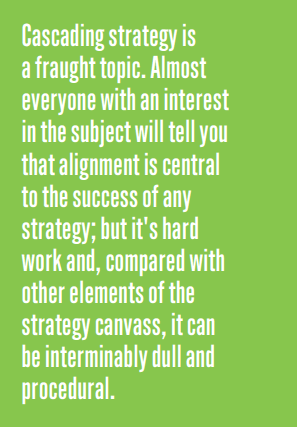Cascading strategy – options for alignment
Cascading managers’ strategies is a useful exercise to promote alignment, but there are many approaches and no dominant paradigm for doing it.
We recommend approaching cascading in a stepwise fashion; keeping it simple; and building interrelated logic, systems and processes over time as the value becomes evident and the organisation’s appetite for alignment grows.
By Dr Marc Levy
 There are many options for cascading and we sometimes encourage clients to crawl and walk before they can run; in some contexts there may be an inverse relationship between complexity and impact.
There are many options for cascading and we sometimes encourage clients to crawl and walk before they can run; in some contexts there may be an inverse relationship between complexity and impact.
Some cascading methods are very simple. For example, Peter Bregman (2013) suggests cascading managers’ priorities.
The way this method can be applied couldn’t be simpler: you ask your CEO and senior team to list the five priorities that they think should occupy 95% of their time (everything else should be done in the remaining 5%); you record everyone’s priorities; you stick them up on a wall in a hierarchy, with the CEO’s on top, direct reports on the next line and so on. Then you review the hierarchy. No one’s helping the CEO with her number four. Exec manager one and exec manager two have the same priority and only one of them should. Really, is that one of your five? And so it goes. This can be an extremely useful exercise to promote alignment, but an obvious challenge to it is that it is input- rather than outcome-driven.
World famous strategy execution thinkers Robert Kaplan and David Norton (2008) suggest cascading strategy maps that might be comprised of 20 or 30 objectives, some of which could be obligatory and others optional or malleable at the business unit level. For example, the learning and growth objectives in their maps, some of which relate to people and culture, may be required objectives; but customer related objectives, which could differ down through different teams, can be moulded within certain parameters to suit specific market circumstances. This makes sense, but decision making relating to what to cascade and how to cascade it can be challenging and imprecise.
Cascading measures (specific concrete performance indicators you can put a number against) may be the hardest of the simple, one dimensional cascades. There may be team measures derived from the corporate strategy that are sufficiently adaptable and ‘cascadable’ to be widely adopted down through the organisation, even into individuals’ performance development plans: measures of financial and operational performance (revenue, cost and productivity); customer metrics like customer satisfaction or net promoter scores; people measures like unwanted turnover. It is certainly possible to cascade scores on climate and engagement surveys, although infrequent data militates against regular performance monitoring. Cascading measures is a technical business: measures and corresponding targets can be hard to define and in our experience many organisations don’t commit to ensuring that measures and targets are accurate, additive and accretive.
Then there’s more complex multifactorial cascades, which tend to be template-driven, often via strategic planning software, but still frequently by lower tech means. One such method is Roger Martin’s OGSM (Lafley & Martin 2013). Many readers will be familiar with his strategic questions, which we sometimes use in our work: What are our aspirations? Where will we choose to play and not play? How will we win? What capabilities will we need? What management systems are necessary to support the strategy? Martin suggests a version of these questions for the cascade via a template that goes to objectives, goals, strategies and measures, the OGSM.
We’ve used a similar template with clients covering goals and attendant measures, strategic priorities and two classical strategy questions used by Martin: where will we compete, specifically, and how will we be distinctive. Our version avoids confusion between objectives and goals and relates measures specifically to objectives.
Multifactorial cascades like these can be effective in aligning organisations around strategies, but they can be convoluted and involved, and they are difficult to employ well. Doing so requires an active input and coaching dialogue between managers throughout the organisation, thoroughness and attention to detail, and very strong measurement, monitoring and review disciplines.
An effective cascade can make a big difference in strategy execution. Like nearly everything in business, senior managers need to make it a priority, and spend the necessary time on it, if they want to get it right. We suggest approaching the cascade in a stepwise fashion. Keep it simple at first and build the interrelated logic, systems and processes over time as the value becomes evident and the organisation’s appetite for alignment grows.
Cascading measures is a technical business: measures and corresponding targets can be hard to define and in our experience organisations frequently don’t commit to ensuring that measures and targets are accurate, additive and accretive.
References
Bregman, P 2013, ‘A personal approach to organisational time management’, McKinsey Quarterly, January
Kaplan, R & Norton, D 2008, Execution Premium: Linking strategy to operations for competitive advantage, Harvard Business School Publishing, Boston
Lafley, A & Martin, R 2013, Playing to win: How strategy really works, Harvard Business Review Press, Boston
(c) 2016 Right Lane Consulting
If you would like Right Lane to help you implement an effective cascading strategy, contact Marc Levy: marc@rightlane.com.au
